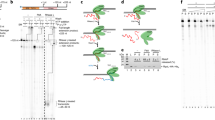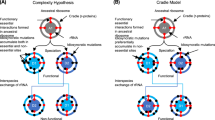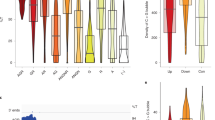Abstract
Archaebacteria have recently become of interest in studies on the phylogeny of organisms, for they are quite different from true bacteria as well as from eukaryotes and are thought to be derived from a separate primary line of descents from true bacteria1. This conclusion is based mainly on nucleotide sequence analysis of 16S ribosomal RNA by Woese and his co-workers, and other genotypic and phenotypic analysis of archaebacteria. To obtain more information on the phylogeny of archaebacteria, we examined the nucleotide sequences of their initiator tRNAs, because much information is available on initiator tRNAs of various organisms, and distinct differences have been found between the sequences of initiator tRNAs of prokaryotes and eukaryotes2. We have now determined the nucleotide sequences of initiator tRNAs from Sulfolobus acidocaldarius, Halococcus morrhuae and Thermoplasma acidophilum, and have found that they have a common unique structural feature that differs from both true bacterial initiator tRNAs and eukaryotic initiator tRNAs.
This is a preview of subscription content, access via your institution
Access options
Subscribe to this journal
Receive 51 print issues and online access
$199.00 per year
only $3.90 per issue
Buy this article
- Purchase on Springer Link
- Instant access to full article PDF
Prices may be subject to local taxes which are calculated during checkout
Similar content being viewed by others
References
Fox, G. E. et at. Science 209, 457–463 (1980).
Gauss, D. H. & Sprinzl, M. Nucleic Acids Res. 10, r1–r55 (1982).
Nishimura, S. in Procedures in Nucleic Acids Research Vol. 2 (eds Cantoni, G. L. & Davies, D. R.) 542–564 (Harper & Row, New York, 1971).
Taya, Y. & Nishimura, S. Biochem. biophys. Res. Commun. 51, 1062–1068 (1973).
Kuchino, Y., Kato, M., Sugisaki, H. & Nishimura, S. Nucleic Acids Res. 6, 3459–3469 (1979).
Kuchino, Y., Watanabe, S., Harada, F. & Nichimura, S. Biochemistry 19, 2085–2089 (1980).
Takeishi, K., Ukita, T. & Nishimura, S. J. biol. Chem. 243, 5761–5769 (1968).
Kilpatrick, M. W. & Walker, R. T. Nucleic Acids Res. 9, 4387–4390 (1981).
Luehrsen, K. R., Nicholson, D. E., Eubanks, D. C. & Fox, G. E. Nature 293, 755–756 (1981).
Matheson, A. T. & Yaguchi, M. in International Cell Biology, 1980–1981 (ed. Schweizer, H. G.) 104–110 (Springer, Berlin, 1981).
Pang, H. et al. J. biol. Chem. 257, 3589–3592 (1982).
Author information
Authors and Affiliations
Rights and permissions
About this article
Cite this article
Kuchino, Y., Ihara, M., Yabusaki, Y. et al. Initiator tRNAs from archaebacteria show common unique sequence characteristics. Nature 298, 684–685 (1982). https://doi.org/10.1038/298684a0
Received:
Accepted:
Issue Date:
DOI: https://doi.org/10.1038/298684a0
This article is cited by
-
The discovery of modified nucleosides from the early days to the present: A personal perspective
Journal of Biosciences (2006)
-
Comparative studies on biochemical properties of protein synthesis of an archaebacteria,Thermoplasma sp.
Origins of Life (1982)
Comments
By submitting a comment you agree to abide by our Terms and Community Guidelines. If you find something abusive or that does not comply with our terms or guidelines please flag it as inappropriate.



